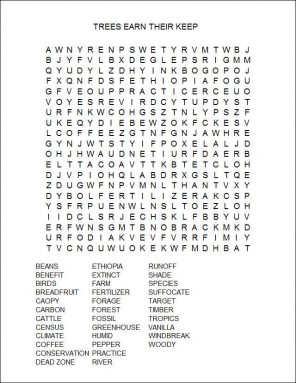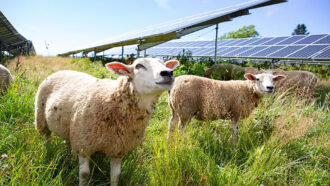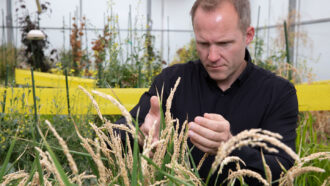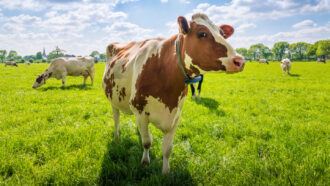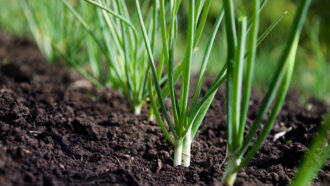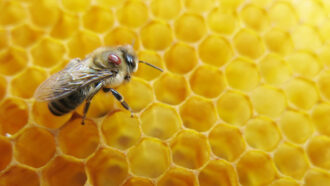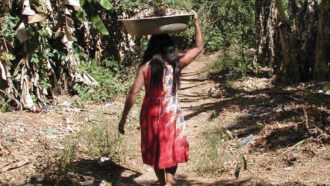Made in the shade
Agroforestry — combining woody plants with agriculture — yields many benefits
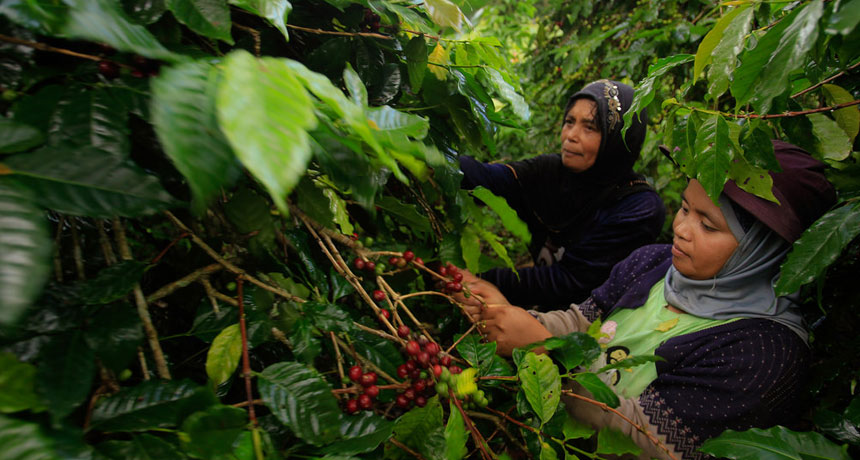
Does this look like a “farm?” These women in Sulawesi, Indonesia, pick coffee beans by hand. Shade grown coffee is prized and can command especially high prices.
Yusuf Ahmad/World Agroforestry Centre/Flickr (CC-BY-NC-SA 2.0)
There’s a bonus to growing coffee in a traditional way that preserves tall trees — and it’s not just for the birds.
Scientists recently found a rich and diverse bird population living in the shade of forested coffee farms. Those farms are in the east African nation of Ethiopia. Ample birdlife is just one of many benefits of this type of farming, called agroforestry. The practice mixes in trees when growing crops or raising livestock.
Combining forest and farm provides habitat for many species of wildlife around the world. The practice can help keep waterways clean and soils healthy. This helps farmers and ranchers. Agroforestry is essential to producing one of the world’s favorite treats — chocolate. And it may even blunt the effects of climate change.
Thanks to growing recognition of its benefits, this ancient farming technique is gaining new attention.
In Ethiopia, agroforestry has been the standard way to grow coffee for more than a thousand years. The coffee plant, Coffea arabica, thrives in the shadows of tall trees. (The word “coffee” comes from the name of an old Ethiopian province named Kaffa.) To farm coffee, growers simply thin the forest of any competing plants. Experts prize the resulting shade-grown coffee beans.
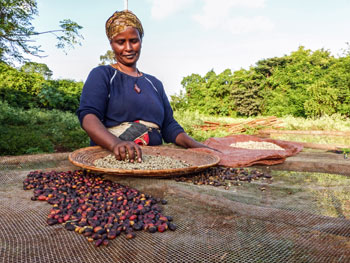
Buechley and his colleagues recently conducted a census of birds on Ethiopia’s farms and in its forests. His team found something special: All the species of birds that could be found in the forest also were living on traditional coffee farms.
Despite its benefits, many farmers are reluctant to adopt agroforestry practices, says Jim Brandle. He is a professor of forestry at the University of Nebraska-Lincoln. People have a difficult time believing it’s worthwhile planting trees on land that could be sown with a profitable crop, he explains. Still, the idea is catching on. India, for example, announced in 2014 that agroforestry would lead its push to add more trees.
Border territory
Long before the technique got its name, humans had used agroforestry to grow plants. The basic idea behind agroforestry is the same, Brandle explains, whether it’s in Africa or halfway around the world in the South Pacific. On Hawaii and other tropical islands in the Pacific Ocean, for instance, farmers have a history of cultivating forests filled with coconut, banana, breadfruit and other trees. Agroforestry is also common elsewhere, even in the continental United States.
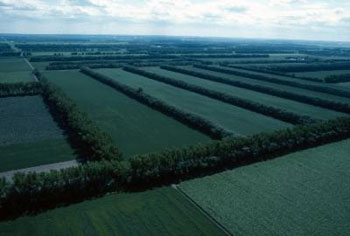
In fact, windbreaks may be one of the most easily recognizable forms of agroforestry in the United States. Planting trees along the edges of a field interrupts the wind, altering its speed, Brandle explains. Next to a windbreak, it’s a little warmer and less windy. Crops grow better in these sheltered areas. The trees also help to protect the soil from wind erosion.
Another common type of agroforestry in the United States takes place along what are called riparian (Ry-PAIR-ee-un) zones. These are regions along the banks of rivers and streams (ripa is Latin for river bank). To create a buffer — or protected area — farmers plant trees and other types of vegetation here. This vegetation helps limit erosion. The plants also provide food and habitat for birds and other wildlife. And the greenery helps prevent rains from washing sediment, nutrients and pesticides away into nearby streams.
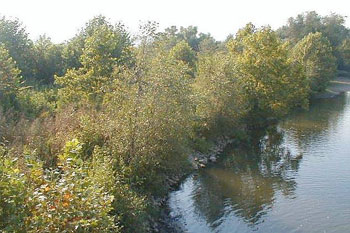
Sometimes, Brandle says, it can be difficult to convince farmers that planting a windbreak or a buffer is a smart move. “There’s the perception that they take land out of production. And they do,” he admits. Still, farmers don’t always recognize the gains that can come from giving ground to more trees.
And it can take time to see those benefits. Unlike many crops, trees take a while to grow, notes Florencia Montagnini. She studies the sustainability of forests and agroforests. She is a research scientist at Yale University in New Haven, Conn. To convince people to plant trees, “what you have to do is show them the benefits of it.”
Sunny prospects for shaded farms
Money can be one of the benefits of agroforestry. It’s something farmers and ranchers appreciate. To earn more, some farmers combine trees with livestock and forage — those plants that the grazers eat. This is yet another type of agroforestry, called silvopasture. (The word combines the Latin word for forest — silva — with a term that describes land grazed by animals.) This practice is often found in the southern United States.
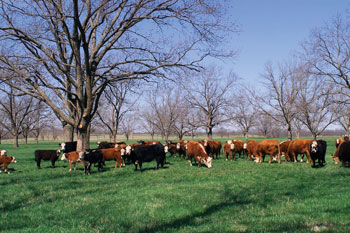
Raising cattle and growing trees on the same land doesn’t just provide two sources of income. It also protects against losses in a bad year. If timber prices fall too low in one year, a farmer can wait to harvest the wood and rely on just the cattle for profit.
Cows also benefit from grazing in pastures that provide shade. That is especially important in warm parts of the world, notes Montagnini. These animals can get overheated out in the sun. When that happens, cattle don’t gain as much weight, make as much milk or birth as many calves. “Very often the trees are something that you need for the cattle to produce more,” she says.
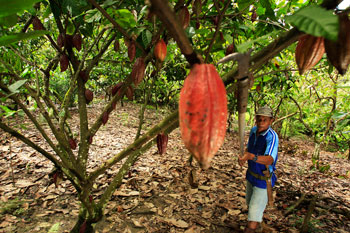
Some farmers will grow coffee or other shade-loving crops in the direct sun because they can fit in more plants. But they often produce a lower quality product. And these less-healthy plants may need chemical pesticides or fertilizers that shade-grown crops wouldn’t. People may be willing to pay high prices for varieties grown in the shade to avoid those chemicals. In Ethiopia, Buechley notes, coffee grown in the shade can bring in $310 more per hectare (2.47 acres) than the same crop grown in full sun.
Benefits for the planet
Agroforestry’s benefits for farmers and the local environment are well known. But now scientists and world leaders think that the practice can do a lot to lessen the impact of much bigger problems. Among them: deforestation and climate change.
In recent years, people have been removing trees from the landscape at an alarming rate. Between 1990 and 2005 alone, people removed more than 16.2 million hectares (63,000 square miles) of forests, reports the United Nations Food and Agriculture Organization. That area is almost as large as the state of Florida.
And the situation is getting worse. Scientists had thought that the rate of deforestation was slowing in the humid tropics. Such areas include the Amazon in South America. But a recent analysis found that the loss of forests in these areas actually sped up by 62 percent between 1990 and 2010. The finding comes from a study published May 16 in Geophysical Research Letters.
Agroforests are not perfect replacements for natural forests. Consider those Ethiopian coffee farms.
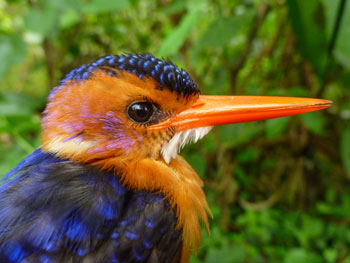
“People have done a lot of research on coffee farms in different parts of the world,” Buechley notes. In many places, forest birds and other animals don’t survive well on farms, even ones that practice agroforestry. In Ethiopia, though, all of the forest species of birds also lived on the coffee farms. But many specialist birds declined in number. These are species that live in only a narrow set of circumstances.
“They didn’t vanish… but their numbers declined by about 80 percent compared to nearby forest,” Buechley says. His conclusion: While shade-grown coffee is a big improvement over most other forms of agriculture, it is not the same as a natural forest. His team’s study appeared February 11in Biological Conservation.
Agroforestry, however, can be a compromise between unnatural fields covered with a single species of plant and the original forest landscape, notes Montagnini at Yale. “Putting trees back on the land would be a way of harmonizing things,” she says. By that she means that those trees can perform several tasks that are good for the environment. These include maintaining habitat for a diverse range of organisms.
India now recognizes agroforestry as perhaps the only way to meet its target of rebuilding forests. The country wants to increase its tree cover to 33 percent. Currently, trees cover less than 25 percent of India.
More trees could also help a global problem — climate change. Largely through burning fossil fuels, people have been emitting lots of carbon dioxide and other greenhouse gases. These gases trap heat in the atmosphere, warming it. Recently, that warming has reached troubling levels. But trees soak up some of that carbon dioxide from the air, notes Montagnini. And trees sequester, or lock up, that carbon dioxide for years.
Farms that grow a single plant crop — such as corn or wheat — don’t sop up as much carbon. Farming practices such as agroforestry, that grow multiple species, could lock up more of the gas, Nair says.
And worldwide, whether it’s a windbreak in Wisconsin or a cocoa farm in Costa Rica, Montagnini notes, “increasing the amount of trees on the land is something that can be achieved.”
Power Words
(for more about Power Words, click here)
agriculture The growth of plants, animals or fungi for human needs, including food, fuel, chemicals and medicine.
agroforestry A type of agriculture that incorporates trees into the landscape.
breadfruit A starchy fruit with a potato-like flavor from a tree that is native to the South Pacific.
canopy (in botany) The top layer of a forest, where the branches of the tallest trees overlap.
carbon dioxide A colorless, odorless gas. Its chemical symbol is CO2. This gas is produced by all animals when the oxygen they inhale reacts with the carbon-rich foods that they’ve eaten. Carbon dioxide also is released when organic matter (including fossil fuels like oil or gas) is burned. Carbon dioxide acts as a greenhouse gas, trapping heat in Earth’s atmosphere. Plants convert carbon dioxide into oxygen during photosynthesis, the process they use to make their own food.
census An official count or survey of a population.
climate change Long-term, significant change in the climate of Earth. It can happen naturally or in response to human activities, including the burning of fossil fuels and clearing of forests.
conservation The act of preserving or protecting the natural environment.
conservation biology A field of science that investigates ways to help preserve ecosystems and especially species that are in danger of extinction.
dead zone An area of open water where oxygen levels are so low that oxygen-dependent organisms cannot live.
deforest The act of removing most or all of the trees lands that used to hold forests.
erosion The process that removes rock and soil from one spot on Earth’s surface, depositing it elsewhere. Erosion can be exceptionally fast or exceedingly slow. Causes of erosion include wind, water (including rainfall and floods), the scouring action of glaciers and the repeated cycles of freezing and thawing that occur in many areas of the world.
fertilizer Nitrogen and other plant nutrients added to soil, water or foliage to boost crop growth or to replenish nutrients that removed earlier by plant roots or leaves.
forage To search for something, especially food. It’s also a term for the food eaten by grazing animals, such as cattle and horses.
greenhouse gas A gas that contributes to the greenhouse effect by absorbing heat. Carbon dioxide is one example of a greenhouse gas.
habitat The area or natural environment in which an animal or plant normally lives, such as a desert, coral reef or freshwater lake. A habitat can be home to thousands of different species.
humidity A measure of the amount of water vapor in the atmosphere. When there is a lot of water present in the air, the conditions are described as humid.
mist net Fine mesh net used by biologists to capture unharmed birds and bats for research.
native Associated with a particular location; native plants and animals have been found in a particular location since recorded history began. These species also tend to have developed within a region, occurring there naturally (not because they were planted or moved there by people). Most are particularly well adapted to their environment.
nutrients Vitamins, minerals, fats, carbohydrates and proteins needed by organisms to live, and which are extracted through the diet.
ornithology The scientific study of birds. Experts who work in this field are known as ornithologists.
oxygen A gas that makes up about 21 percent of the atmosphere. All animals and many microorganisms need oxygen to fuel their metabolism.
pesticide A chemical or mix of compounds used to kill insects, rodents or other organisms harmful to cultivated plants, pet or livestock, or unwanted organisms that infest homes, offices, farm buildings and other protected structures.
riparian An adjective that refers to a strip of land near the edge of a waterway, usually a river or stream.
runoff The water that runs off of land into rivers, lakes and the seas. As that water travels over land, it picks up bits of soil and chemicals that it will later deposit as pollutants in the water.
sediment Material (such as stones and sand) deposited by water, wind or glaciers.
sequester To set apart or withdraw. Pollution engineers, for instance, often talk about sequestering carbon dioxide, a leading greenhouse gas associated with global warming, by collecting it for reuse in chemical processes or for long-term burial. Known as carbon sequestration, this process is not yet in commercial use and may carrying serious side effects.
silvopasture A type of farming in which trees are grown in areas where cattle or other livestock are also being raised.
species A group of similar organisms capable of producing offspring that can survive and reproduce.
sustainability To use resources in a way that they will continue to be available in the future.
tagging (in biology) Attaching some rugged band or package of instruments onto an animal. Sometimes the tag is used to give each individual a unique identification number. Once attached to the leg, ear or other part of the body of a critter, it can effectively become the animal’s “name.” In some instances, a tag can collect information from the environment around the animal as well. This helps scientists understand both the environment and the animal’s role within it.
timber Trees grown as a source of wood for human needs.
tropics The region near Earth’s equator. Temperatures here are generally warm to hot, year-round.
understory Plants that grow beneath the canopy, or uppermost level, of the forest.
vegetation Leafy, green plants. The term refers to the collective community of plants in some area. Typically these do not include tall trees, but instead plants that are shrub height or shorter.
windbreak A line of trees that serves to protect an area from erosion and damage that can be caused by winds.
Word Find (click here to enlarge for printing)
